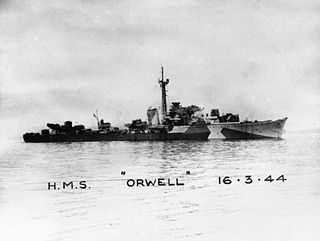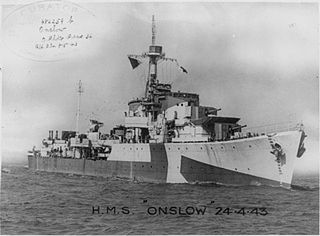
The Grimsby-class sloops were a class of 13 sloops-of-war laid down between 1933 and 1940. Of these, eight were built in the United Kingdom for the Royal Navy, four in Australia for the Royal Australian Navy and one for the Royal Indian Navy. Main armament was initially two 4.7-inch (120 mm) guns for RN ships and three 4-inch (100 mm) for Australian ships, but armament varied considerably between ships, and was increased later.

HMS Orwell was an O-class destroyer of the Royal Navy that entered service in 1942 and was broken up in 1965.

HMS Onslow was an O-class destroyer of the Royal Navy. The O-class were intermediate destroyers, designed before the outbreak of the Second World War to meet likely demands for large number of destroyers. They had a main gun armament of four 4.7 in guns, and had a design speed of 36 kn. Onslow was ordered on 2 October 1939 and was built by John Brown & Company at their Clydebank, Glasgow shipyard, launching on 31 March 1941 and completing on 8 October 1941.

HMS Aberdeen was a Grimsby-class sloop in the British Royal Navy. Built in Devonport Dockyard, Plymouth, UK by Thornycroft, she was launched on 22 January 1936.

HMS Termagant was a T-class destroyer of the Royal Navy that saw service during the Second World War. She was built by William Denny and Brothers, of Dumbarton and launched on 22 March 1943. She was scrapped in 1965.

HMS Dundee was a Shoreham-class sloop of the British Royal Navy. The ship was built at Chatham Dockyard, entering service in 1933.

HMS Magpie, pennant number U82, was a Royal Navy Modified Black Swan-class sloop launched in 1943 and broken up in 1959. She was the seventh Royal Navy ship to bear the name. She was reclassified as a frigate in 1947, receiving a new pennant number F82. The ship was the only vessel commanded by Prince Philip, Duke of Edinburgh, who took command on 2 September 1950, when he was 29.

HMS Folkestone was a Hastings-class sloop of the Royal Navy that saw action in World War II. She was built by Swan Hunter and Wigham Richardson Ltd. of Wallsend-on-Tyne, laid down on 21 May 1929 and launched on 12 February 1930. She was commissioned on 25 June 1930 under the pennant number L22/U22.

HMS Bridgewater (L01) was the lead ship of her class of sloops built for the Royal Navy in the 1920s. Completed in 1929, the ship was initially assigned to the China Station and then joined the Commander-in-Chief, Africa in 1935. During the Second World War, Bridgewater spent most of her time on convoy escort duties off the West African coast although she did play a minor role in the Battle of Dakar in 1940. She was replaced in that role before the end of the war by more modern ships and was relegated to training duties in the UK. The ship was reduced to reserve shortly after the end of the war and was sold for scrap in 1947.

HMS Bideford was a Royal Navy Shoreham-class sloop. She was named after the town of Bideford in Devon and was launched on 1 April 1931.

The third HMS Penzance (L28) was a Hastings-class sloop launched in 1930, and torpedoed and sunk in 1940 whilst on convoy protection duty by the German submarine U-37 with the loss of 90 of her 104 crew. She was named after the Cornish port of Penzance and was the third Royal Navy ship to bear that name.

HMS Grimsby was a sloop of the British Royal Navy, the lead ship of her class. Grimsby was built in the 1930s, entering service in 1934. Serving most of her pre-war service at Hong Kong, Grimsby was deployed on convoy escort duties along the East coast of the Britain and in the Mediterranean Sea during the Second World War, and was sunk by dive bombers off Tobruk on 25 May 1941.

HMS Lowestoft was a Grimsby-class sloop of the Royal Navy. Built at Devonport Dockyard in the 1930s, Lowestoft was launched in 1934 and commissioned later that year. She served on the China Station, based at Hong Kong until the outbreak of the Second World War. Lowestoft served as a convoy escort during the war, both in the North Atlantic and off the west coast of Africa.

HMS Deptford was a Grimsby-class sloop of the British Royal Navy. Built at Chatham Dockyard in the 1930s, Deptford was launched in 1935 and commissioned later that year. The ship saw early service on the Persian Gulf station, but the outbreak of the Second World War saw Deptford serving as a convoy escort in the North Atlantic and the Mediterranean, sinking a German U-boat in 1941. She survived the war and was scrapped in 1948.

HMS Londonderry was a Grimsby-class sloop of the Royal Navy. Built at Devonport Dockyard in the 1930s, Londonderry was launched in early 1935 and commissioned later that year. She served in the Red Sea and the South Atlantic until the outbreak of the Second World War. Londonderry served as a convoy escort during the war, which she survived. The ship was sold for scrap in 1948.

HMS Fleetwood was a Grimsby-class sloop of the Royal Navy. Built at Devonport Dockyard in the 1930s, Fleetwood was launched in March 1936 and commissioned in November that year. She served in the Red Sea until the outbreak of the Second World War. Fleetwood served as a convoy escort during the war, which she survived, and sank the German submarines U-528 and U-340. Post-war, the ship served as a radar training ship, remaining in use until 1959, when she was scrapped.

HMS Milford was a Shoreham-class sloop of the British Royal Navy built at Devonport Dockyard in 1931–1932. After peacetime operations on the Africa Station during the 1930s, Milford served during the Second World War. Her wartime service between 1939 and 1943 mostly involved convoy escort duties off Africa, but in 1940 she also took part in Operation Catapult and Operation Menace, both targeting Vichy French forces at Dakar, Senegal, and in the Battle of Gabon, in which she damaged the Vichy French submarine Poncelet so severely that Poncelet scuttled herself. After training duty in 1944 and 1945, Milford was placed in reserve in 1946 and sold in 1949.

HMS Falmouth was a Shoreham-class sloop of the British Royal Navy. Falmouth was built at Devonport Dockyard in 1931–1932. The ship was used as a despatch vessel on the China Station in the 1930s, but the Second World War resulted in her being rearmed, and used for escort duties. From 1952, Falmouth was used as a stationary drillship until she was scrapped in 1968.

HMS Weston was a Shoreham-class sloop of the British Royal Navy. Weston was built at Devonport Dockyard in 1931–1933.

HMS Crane was a modified Black Swan-class sloop of the Royal Navy. She was laid down by William Denny and Brothers, Dumbarton on 13 June 1941, launched on 9 November 1942 and commissioned on 10 May 1943, with the pennant number U23. The saw active service during the Second World War, performing convoy escort roles in the Atlantic initially before supporting the Normandy landings. In the final months of the war, Crane joined the British Pacific Fleet with whom the vessel saw service during the Battle of Okinawa. Post war, Crane remained in south-east Asia and took part in hostilities during the Korean War. She was redeployed to the Middle East during the Suez Crisis before returning to Asia for service during the Malayan Emergency. Crane was withdrawn from service in the early 1960s and scrapped in 1965.



















